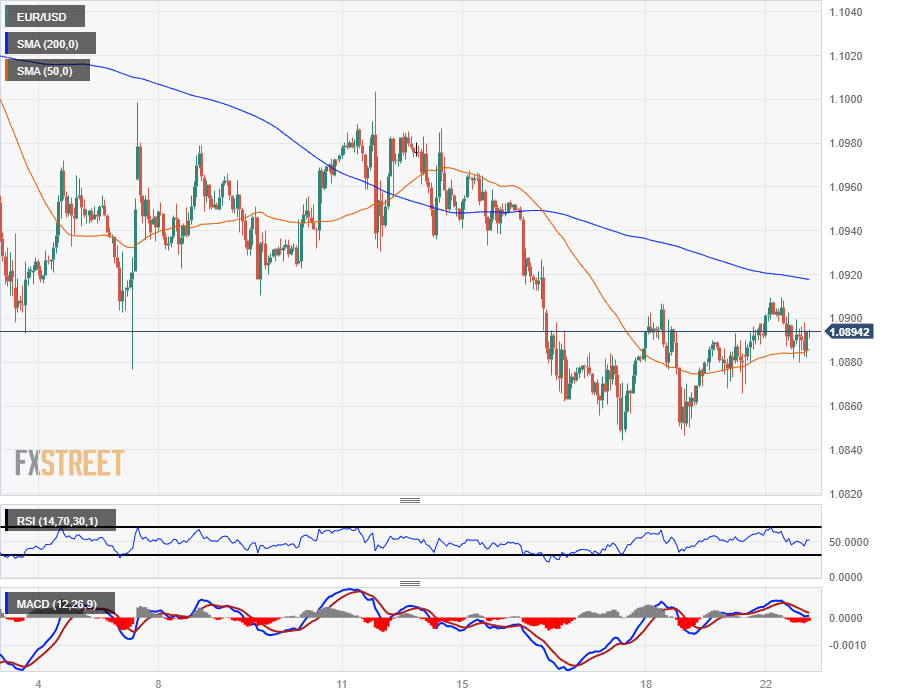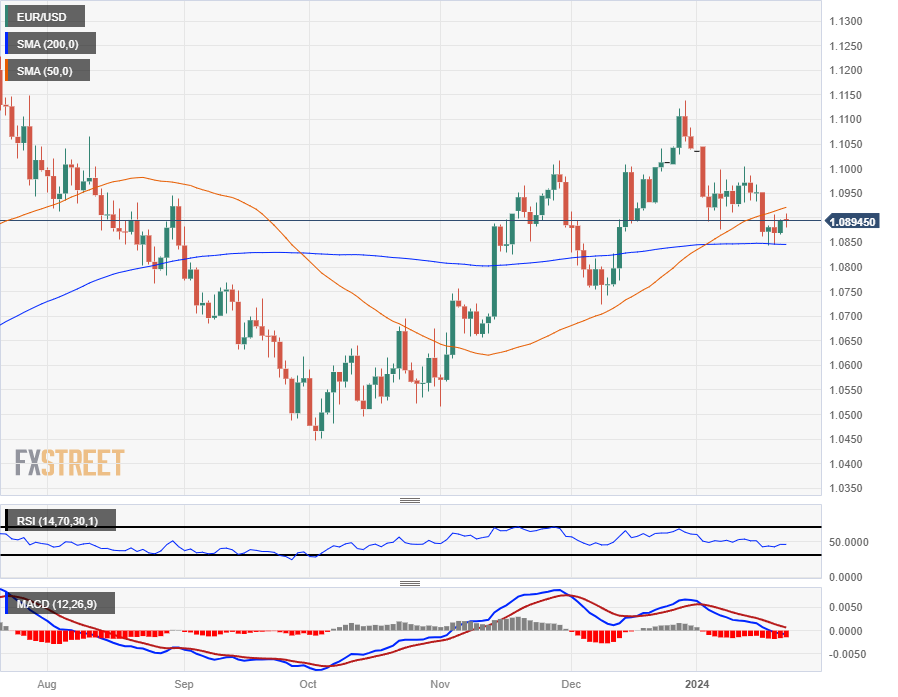EUR/USD churns as markets gear up for this week’s European PMIs, ECB rate call
EUR/USD continues to grow vexed by 1.0900 level in the near term.
Europe inflation, ECB rate call in the pipe midweek.
ECB Bank Lending Survey, euro area January Consumer Confidence due Tuesday.
The EUR/USD is shuffling its feet on Monday as traders take the opportunity to gather themselves up ahead of this week’s hectic showing from multiple central banks across the globe.
Europe sees an update from the European Central Bank’s (ECB) Bank Lending Survey and January’s preliminary Consumer Confidence report, both due on Tuesday. Wednesday drops a fresh round of euro area Purchasing Manager Index (PMI) figures, and investors will be bracing for another rate call from the ECB on Thursday.
Daily digest market movers: EUR/USD continues to hold near 1.0900 after trimming gains last week
- A quiet Monday is set to give way to a hectic midweek with an ECB rate call taking center stage.
- Market expectations of rate cuts in 2024 have run well ahead of what policymakers might be able or willing to deliver.
- ECB is firmly entrenched in holding rates steady until summer at the earliest, barring any significant developments in economic data.
- Tuesday’s euro area Consumer Confidence in January is forecast to tick up from -15.0 to -14.3.
- Wednesday’s pan-EU HCOB Composite PMI is expected to rebound slightly in January from 47.6 to 48.0.
- Germany’s HCOB Composite PMI is likewise seen rising from 47.4 to 47.8 in January.
- With the ECB functionally guaranteed to hold its main reference rate at 4.5% on Thursday, investors will be deep-diving on the ECB’s ensuing Monetary Policy Statement.
Euro price today
The table below shows the percentage change of Euro (EUR) against listed major currencies today. Euro was the strongest against the New Zealand Dollar.
| USD | EUR | GBP | CAD | AUD | JPY | NZD | CHF | |
| USD | 0.08% | -0.04% | 0.34% | 0.37% | -0.04% | 0.67% | 0.05% | |
| EUR | -0.08% | -0.12% | 0.25% | 0.28% | -0.12% | 0.59% | 0.00% | |
| GBP | 0.04% | 0.12% | 0.37% | 0.42% | 0.00% | 0.72% | 0.09% | |
| CAD | -0.34% | -0.25% | -0.38% | 0.03% | -0.37% | 0.34% | -0.29% | |
| AUD | -0.37% | -0.28% | -0.41% | -0.02% | -0.40% | 0.31% | -0.31% | |
| JPY | 0.03% | 0.10% | 0.04% | 0.38% | 0.41% | 0.72% | 0.09% | |
| NZD | -0.68% | -0.60% | -0.73% | -0.35% | -0.31% | -0.72% | -0.64% | |
| CHF | -0.05% | 0.03% | -0.09% | 0.29% | 0.31% | -0.09% | 0.61% |
The heat map shows percentage changes of major currencies against each other. The base currency is picked from the left column, while the quote currency is picked from the top row. For example, if you pick the Euro from the left column and move along the horizontal line to the Japanese Yen, the percentage change displayed in the box will represent EUR (base)/JPY (quote).
Technical Outlook: EUR/USD remains caught in consolidation as markets await midweek releases
The EUR/USD continues to trade into a technical midrange between major moving averages as markets reach a shaky equilibrium between rate expectations and economic outlook between the Euro (EUR) and the US Dollar (USD). Intraday action continues to squeeze into chart space near 1.0900, capped off by the 200-hour Simple Moving Average (SMA) near 1.0920.
The Euro is down 1.3% against the US Dollar in 2024 so far. Despite the recent decline, the EUR/USD is stubbornly holding onto technical levels. Daily candlesticks see the EUR/USD drifting within chart paper between the 50-day and 200-day SMAs at 1.0921 and 1.0845, respectively.
The pair’s long-term momentum is still leaning bullish as higher lows continue to march upwards, but topside gains are beginning to thin out and the 1.1000 handle is beginning to form into a hard technical resistance barrier.
EUR/USD Hourly Chart
EUR/USD Daily Chart
ECB FAQs
What is the ECB and how does it influence the Euro?
The European Central Bank (ECB) in Frankfurt, Germany, is the reserve bank for the Eurozone. The ECB sets interest rates and manages monetary policy for the region.
The ECB primary mandate is to maintain price stability, which means keeping inflation at around 2%. Its primary tool for achieving this is by raising or lowering interest rates. Relatively high interest rates will usually result in a stronger Euro and vice versa.
The ECB Governing Council makes monetary policy decisions at meetings held eight times a year. Decisions are made by heads of the Eurozone national banks and six permanent members, including the President of the ECB, Christine Lagarde.
What is Quantitative Easing (QE) and how does it affect the Euro?
In extreme situations, the European Central Bank can enact a policy tool called Quantitative Easing. QE is the process by which the ECB prints Euros and uses them to buy assets – usually government or corporate bonds – from banks and other financial institutions. QE usually results in a weaker Euro.
QE is a last resort when simply lowering interest rates is unlikely to achieve the objective of price stability. The ECB used it during the Great Financial Crisis in 2009-11, in 2015 when inflation remained stubbornly low, as well as during the covid pandemic.
What is Quantitative tightening (QT) and how does it affect the Euro?
Quantitative tightening (QT) is the reverse of QE. It is undertaken after QE when an economic recovery is underway and inflation starts rising. Whilst in QE the European Central Bank (ECB) purchases government and corporate bonds from financial institutions to provide them with liquidity, in QT the ECB stops buying more bonds, and stops reinvesting the principal maturing on the bonds it already holds. It is usually positive (or bullish) for the Euro.